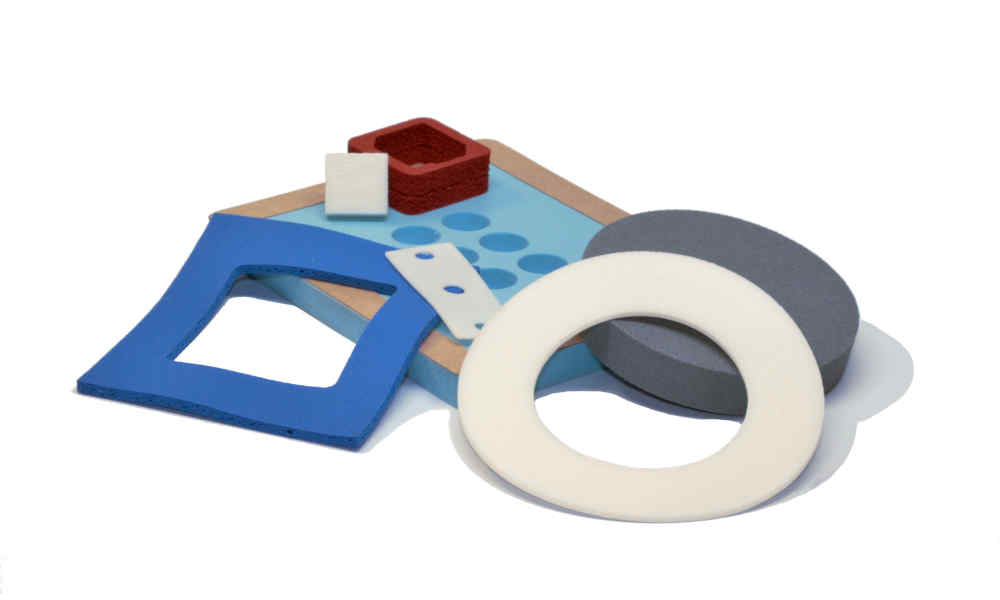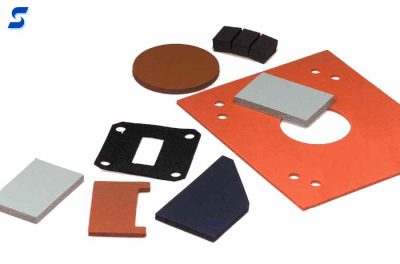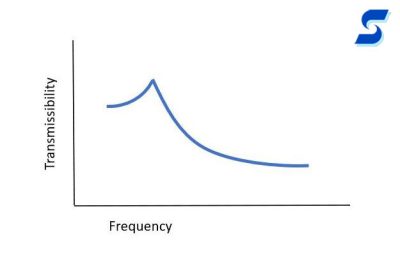Custom Gaskets
Vibration Dampening Pads
Pads designed and fabricated to meet application requirements
Pads designed and fabricated to meet application requirements

Vibration dampening is also called vibration damping; the terms are used interchangeably. Vibration dampening absorbs the vibrational kinetic energy that enters an object and dissipates this energy as heat. Vibration damping, as vibration dampening is also known, is different from vibration isolation, which prevents vibrations from entering. Within systems such as electronic devices, vehicles, and buildings, both forms of vibration management may be used.
To dampen vibrations, sheets of silicone foam or urethane foam can be die cut or water jet cut into products called vibration dampening pads. Injection molding can also be used to produce custom pads, or to mold bumpers. The materials that are used are viscoelastic, meaning that they exhibit both viscous and elastic characteristics when undergoing deformation. It’s this combination of characteristics that supports vibration dampening, typically at discrete points such as the edges of panels.

Vibration damping pads (also call vibration dampening pads) are used to absorb mechanical energy for overall system protection. Using a vibration damping pad can isolate the vibration source and the energy is dissipated as low level heat.
EXAMPLE: An electronics rack enclosure with cooling fans directly mounted to the chassis where the vibration generated by that fan can loosen fasteners and generate unwanted rattles.
Damping is a function of mass, frequency, surface area, and other factors including temperature. Damping pads can be made from a range of materials, one of the more common materials specified is Rogers PORON® urethane foam. PORON is a microcellular foam supplied in a variety of densities and thicknesses that allow for fine tuning. PORON has excellent rebound over a long time frame making it more reliable than other polymers. Urethane foam is affected by temperature, so for outdoor and cold temperature applications silicone foam is a better choice.Contact Us for further assistance with custom vibration dampening pads.
Mechanical shock is thought of as an independent event as compared to a continuous frequency like vibration.
EXAMPLE: A mobile phone is dropped onto a concrete surface. The external casing offers some energy absorption but internal components are still subject to relative high g-forces.
Within handheld devices there are resilient foam pads, commonly foam products (urethane, silicone, etc.) that are design to absorb the impact energy by controlling the rapid deceleration. Rogers PORON 4790-92 is a unique product that is very lossy or dampening -meaning it absorbs a lot of energy and does not return the energy. “Ruggedizing” is becoming much more common, as more and more devices are becoming portable, such as GPS devices, cell phones, handheld scanners, portable instruments and sensors. Contact Us for further assistance with custom shock absorbing pads.
Stockwell Elastomerics converts both silicone foam, including Rogers’ BISCO® silicone foam and Saint-Gobain’s NORSEAL® silicone foam, and urethane foam – Rogers PORON®. Silicone foams have outdoor and cold-temperature advantages, but PORON® urethane foams have a fine-pitch, open-cell structure for excellent compression resistance. Stockwell Elastomerics helps customers to select the right vibration dampening material for their applications and offers expert fabrication services.
Three selection criteria are used to choose between silicone foam and urethane foam for vibration dampening, with details on each below:
When stress is applied, viscous materials resist shear flow and strain linearly with time. Elastic materials strain when stretched but immediately return to their original state when stress is removed. On a stress-strain curve, viscoelastic materials exhibit hysteresis, a dynamic lag between an input and an output that is non-linear (i.e., variable). According to industry experts Instron’s glossary, “elastic hysteresis is the difference between the strain energy required to generate a given stress in a material, and the material’s elastic energy at that stress.” In simple terms, hysteresis describes a material’s ability to absorb energy, since the elastic potential energy at a given state is less than the energy it took to get to that state – for example, that “missing energy” could be due to heat generation in the material (the energy is not actually missing – that would be impossible!). This is great for vibration dampening because it lowers a material’s energetic response to an input force or frequency.
Different materials have varying degrees of hysteresis. By dividing a material’s elastic hysteresis by its elastic deformation energy, it’s possible to calculate an elastomer’s damping capacity. Elastomers where hysteresis is more pronounced are able to disperse larger amounts of energy and can be used to absorb vibrations and sound. Although silicone and urethane foams exhibit some stress relaxation and creep, they are superior to other elastomers for vibration dampening applications.
Silicone foams have better environmental resistance and broader temperature resistance than urethane foams, especially at low temperatures. For vibration dampening, however, frequency and transmissibility are key considerations. By graphing these values against each other, suppliers of vibration dampening materials provide transmissibility curves that show damping performance. Engineers can then evaluate these curves while also considering the application’s temperature and environment.
Natural frequency, or resonant frequency, is the frequency at which a material will naturally vibrate. It is measured in Hertz (Hz) and, in its simplest form, is a function of mass and stiffness. When engineered systems or structures vibrate at their natural frequencies, there are oscillations with very large amplitudes of deflection. Practically speaking, the results can range from excessive shaking or component wear to, ultimately, component or system failure.
Transmissibility, the second concept, is the ratio of the vibrational force that is measured within a system to the vibrational force that’s emerging from a system. The unit of measure is decibels (dB), and the equation for converting the ratio into decibels is dB = 10LOG(Ao/Ai). By plotting frequency on the X-axis in Hertz (Hz) and transmissibility on the Y-axis in decibels (dB), material suppliers can provide the transmissibility curves that engineers need.
The transmissibility curves for vibration dampening materials have both an upslope and a downslope. During the upslope, transmissibility rises as the frequency increases. The curve has a peak, however, and this peak represents the natural frequency. There is then a downslope where transmissibility declines as frequency increases. Because larger losses of energy mean better dampening, it’s this downslope that indicates dampening effectiveness.
 The graph shown here is a representation of a general transmissibility curve for a vibration dampening foam. While there are no numbers to reference, the shape of the graph is important. As frequency increases – aka the input vibration – there is a sharp and quick increase in transmissibility. The peak on this curve represents the natural frequency. At this value, there will actually be extremely negative effects from a vibration point of view. The vibration of the system will increase quite drastically (a famous example is a collapsing bridge in the wind). Beyond this peak, proper vibration dampening occurs, and the material reduces input vibration.
The graph shown here is a representation of a general transmissibility curve for a vibration dampening foam. While there are no numbers to reference, the shape of the graph is important. As frequency increases – aka the input vibration – there is a sharp and quick increase in transmissibility. The peak on this curve represents the natural frequency. At this value, there will actually be extremely negative effects from a vibration point of view. The vibration of the system will increase quite drastically (a famous example is a collapsing bridge in the wind). Beyond this peak, proper vibration dampening occurs, and the material reduces input vibration.
Contact Us for further assistance with vibration damping pads and shock absorbing pads.